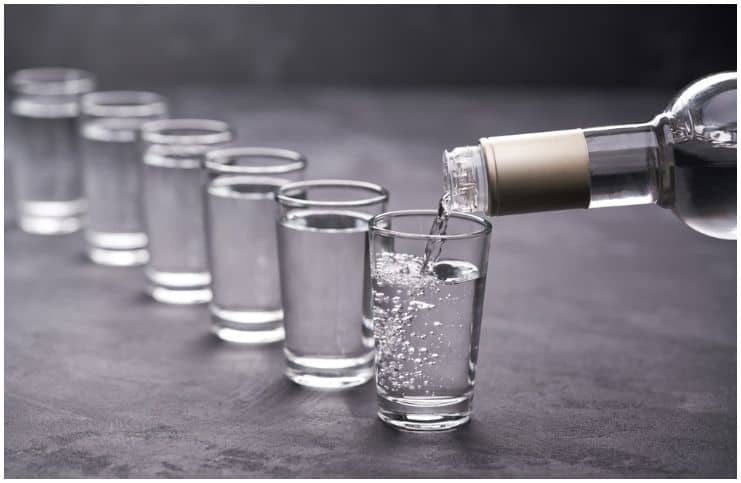This article reveals the history and differences between two brands of vodka – Svedka and Smirnoff:
Svedka
It is a Swedish brand of vodka that is produced in Lidköping, a locality in Västra Götaland County, Sweden.
The flavored versions are 75 proof or 37.5% alcohol, while the spirit is 80 proof or 40% alcohol.
The product name is a portmanteau of the words Svenska or Sverige or (“Swedish” and “Sweden” respectively in the Swedish language) and the word “vodka.”
The brand was imported and introduced to the United States from Sweden in 1998.
In 2007, it was acquired by Constellation Brands Inc. (an international marketer and producer of spirits, wine, and beer) for US$384 million.
Production Process
This type of vodka is made via “continuous distillation” to ensure that ingredients are continually moving, hence, the winter wheat, water, and yeast never stalls or pools.
In the last part of the production, the vodka is run through 5 separate times of purification columns to remove any impurities.
It takes about four pounds of locally grown winter wheat to make each bottle of vodka.
Stats
According to statistics, it is now the largest imported vodka brand in the US.
In 2015 alone, the brand registered an increase of 2.9 percent (approximately 4.2 million sold cases).
Diana Pawlik, SVEDKA’s Vice President of Marketing, stated:
“We are so proud that we have hit this important sales milestone and SVEDKA continues to grow and flourish in such a competitive market.”
Flavors
It has the following flavors:
- piña colada;
- vanilla;
- raspberry;
- clementine;
- cherry;
- citron.
In March 2017, the brand released blue raspberry flavor.
Diana Pawlik said:
“SVEDKA constantly looks to break the mold by introducing bold flavors to the vodka category, and we’re excited to unveil SVEDKA Blue Raspberry as the newest dynamic addition to our award-winning portfolio.”
It comes in 50ML, 375ML, 750ML, 1L, and 1.75L.
However, Svedka’s identity remains 80-proof vodka.
Pawlik also said:
“The bottom line for us is that quality equation. Our flavors allow us to have a fuller conversation with our customers now, but our reputation is based on our 80-proof vodka.”
Smirnoff
The brand traces its origins back to pre-Revolutionary Russia, to a distillery established in 1864 by Pyotr Arseneyevich Smirnov.
According to his great-granddaughter, Galina Tchinyaeva, Piotr Smirnov was born in 1831 in a village called Kaiurovo.
To market his product, Piotr Smirnov made charitable donations to the clergy to keep them from preaching anti-vodka sermons. He also advertised in newspaper ads.
In 1877, the Smirnov vodka company was awarded the right to use three Russian State coats of arms.
In 1886, the Smirnov factory received the mark of Purveyor to the Imperial Russian Court.
Piotr Smirnov died in 1889. At the time, his company was generating the equivalent of $23 million per year in revenues, produced more than 4,000,000 cases of liqueurs, spirits, and wines, and employed more than 1,500 people.
After the passing of Piotr Smirnov, his son, Vladimir Smirnov, took over the company.
Smirnoff vodka was registered in Europe in the 1920s.
In 1933, Vladimir Smirnov sold the right to begin producing the vodka in North America to Kunett.
In 1939, John Martin, president of Heublein bought the rights of the brand.
After WWII, Smirnoff vodka (known at the time as white whiskey) started to become a household name in the US.
By the mid-1970s, the brand had become second best sold America’s top-selling spirit.
In 1982, the R. J. Reynolds Tobacco Company acquired Heublein for $1.4 billion.
In 1987, RJR Nabisco sold the division to Grand Metropolitan.
In 1994, Smirnoff Black is introduced in the US.
In 1997, Grand Metropolitan merged with Guinness to form Diageo.
In 2017, Chrissy Teigen starred in video ads for the vodka.
Production Process
It is prepared by passing vodka through columns of birch charcoals for 10 times. Charcoal filtration is thought to mellow a spirit by removing further impurities. It was the first company to use charcoal as a filter for vodka.
The brand is produced in 16 countries.
Flavors
Some of the flavors of the Smirnoff brand are:
- pomegranate;
- electric berry;
- ice raspberry;
- Norwegian berries;
- peppermint;
- electric mandarin;
- coffee;
- wild grape;
- root beer;
- espresso;
- watermelon;
- fruit punch;
- green apple.
Bottom Line – Svedka vs Smirnoff
Svedka is a brand of vodka that has universal appeal, with a consumer base split evenly female/male. It has won several category accolades and awards, including:
- 2012 – Impact’s “Hot Brand” award;
- 2010 – Growth Brand Awards;
- 2011 – the Fast Track Award at Beverage Information Group;
- 2012 – Impact’s “Blue Chip” Brand Award;
- 2014 – the International Wine and Spirits Competition.
Smirnoff is the second world’s largest selling spirit brand, after India’s Officer’s Choice. In the United Kingdom, Smirnoff is the number one vodka brand, while in the US it holds down the top spot on the list of the best-selling vodka brands.
It is sold in 130 countries and is produced using a process involving 10 stages of filtration.
Smirnoff’s most renowned expression is a classic Russian style vodka with a cool finish, light fragrance, and clean taste – Smirnoff No. 21 vodka.
Both brands of vodka are a good choice of alcohol enthusiasts. Regarding their production process, Smirnoff is the better choice since it involves 10 stages of filtration versus 5 stages of filtration used by Svedka.
Regarding their price, both brands have a similar price, around $17 for a bottle of 750 ml. Regarding their taste, both brands have plenty of flavors.
References https://www.prnewswire.com/svedka-vodka-continues-to-lead-category-innovation https://www.thrillist.com/things-you-didnt-know-about-smirnoff-vodka https://www.independent.co.uk/a-strange-case-of-smirnoff-1527913.html
